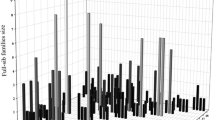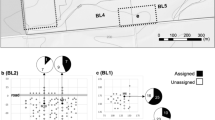Summary
A method for quantifying mating behavior in clonal seed orchards of forest tree species is presented. It involves the estimation of effective numbers of pollen parents from seed samples collected from individual ramets in such orchards. These effective numbers are variance effective numbers for populations of male gametes that are successful in uniting with ovules to produce viable seed. Three such effective numbers are defined for clonal seed orchards:N p (a) for male gamete populations for ramets within clones,N p (b) for male gamete populations for clones, andN p (c) for male gamete populations for entire orchards. Estimators for these effective numbers and for standardized variances of allele frequencies in the male gametic populations are presented. Expressions are also given for the confidence intervals for each of the three effective numbers. Estimates of these parameters and the corresponding confidence intervals for two seed orchards are presented and interpreted.
Similar content being viewed by others
References
Apsit VJ, Nakamura RR, Wheeler NC (1989) Differential male reproductive success in Douglas fir. Theor Appl Genet 77: 681–684
Askew GR (1988) Estimation of gamete pool compositions in clone seed orchards. Silvae Genet 37:227–232
Crow JF, Denniston C (1988) Inbreeding and variance effective population numbers. Evolution 42:482–495
Daniels JD (1978) Efficacy of supplemental mass pollination in Douglas fir seed orchards. Silvae Genet 27:52–58
El-Kassaby YA, Askew GR (1991) The relation between reproductive phenology and reproductive output in determining the potential gametic pool profile in a Douglas fir seed orchard. For Sci (in press)
El-Kassaby YA, Ritland K (1986) Low levels of pollen contamination in a Douglas fir seed orchard as detected by allozyme markers. Silvae Genet 35:224–229
El-Kassaby AY, Fashler AMK, Sziklai O (1984) Reproductive phenology and its impact on genetically improved seed production in a Douglas fir seed orchard. Silvae Genet 33:120–125
El-Kassaby YA, Fashler AMK, Crown M (1989) Variation in fruitfulness in a Douglas fir seed orchard and its effect on crop management decisions. Silvae Genet 38:113–120
Fashler AMK, El-Kassaby YA (1987) The effect of water spray cooling treatment on reproductive phenology in a Douglas fir seed orchard. Silvae Genet 36:245–249
Friedman ST, Adams WT (1985) Estimation of gene flow into two seed orchards of loblolly pine (Pinus taeda L.). Theor Appl Genet 69:609–615
Griffin AR (1982) Clonal variation in radiata pine seed orchards. I. Some flowering, cone, and seed production traits. Aust For Res 12:295–302
Griffin AR (1984) Clonal variation in radiata pine seed orchards. II. Flowering phenology. Aus For Res 14:271–281
Kimura J, Crow JF (1963) The measurement of effective population number. Evolution 17:279–288
Krimbas CB, Tsakas S (1971) The genetics ofDacus oleae. V. Changes of esterase polymorphism in a natural population following insecticide control — selection or drift? Evolution 25:454–460
Lewontin RC, Krakauer J (1973) Distribution of gene frequency as a test of the theory of the selective neutrality of polymorphisms. Genetics 74:175–195
Nei M, Tajima F (1981) Genetic drift and estimation of effective population size. Genetics 98:625–640
Pollak E (1983) A new method for estimating the effective population size from allele frequency changes. Genetics 104: 531–548
Rao CR (1973) linear statistical inference and its applications, 2nd edn. John Wiley, New York
Ritland K, El-Kassaby YA (1985) The nature of inbreeding in a seed orchard of Douglas fir as shown by an efficient multilocus model. Theor Appl Genet 71:375–384
Schmidtling RC (1983) Genetic variation in fruitfulness in a loblolly pine (Pinus taeda L.) seed orchard. Silvae Genet 32:76–80
Shaw DV, Allard RW (1982) Estimation of outcrossing rates in Douglas fir using isozyme markers. Theor Appl Genet 62:113–120
Waples RS (1989) A generalized approach for estimating effective population size from temporal changes in allele frequency. Genetics 121:379–391
Wright S (1931) Evolution in Mendelian populations. Genetics 16:97–159
Author information
Authors and Affiliations
Additional information
Communicated by P.M.A. Tigerstedt
Rights and permissions
About this article
Cite this article
Roberds, J.H., Friedman, S.T. & El-Kassaby, Y.A. Effective number of pollen parents in clonal seed orchards. Theoret. Appl. Genetics 82, 313–320 (1991). https://doi.org/10.1007/BF02190617
Received:
Accepted:
Issue Date:
DOI: https://doi.org/10.1007/BF02190617




